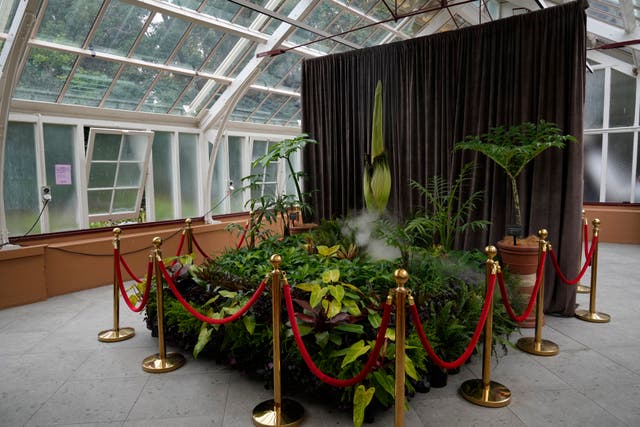Thousands queue to see rare plant which emits stink of death when it blooms
For a week the plant has graced a gothic display in front of a purple curtain and wreathed in mist from a humidifier at Sydney’s Royal Botanic Garden.

The rare unfurling of an endangered plant that emits the smell of decaying flesh has drawn devoted fans to a greenhouse in Sydney where they joined three-hour lines to experience a momentous bloom – and a fragrance evoking gym socks and rotting rubbish.
Tall, pointed and smelly, the corpse flower is scientifically known as amorphophallus titanum – or bunga bangkai in Indonesia, where the plants are found in the Sumatran rainforest.
But to fans of this specimen, she is Putricia – a portmanteau of “putrid” and “Patricia” eagerly adopted by her followers who, naturally, call themselves Putricians.

Her rise to fame since has been rapid, with up to 20,000 admirers filing past for a moment in her increasingly pungent presence.
No corpse flower has bloomed at the garden for 15 years.
The plant only flowers every seven to 10 years in the wild.
“The fact that they open very rarely, so they flower rarely, is obviously something that puts them at a little bit of a disadvantage in the wild,” said garden spokesperson Sophie Daniel, who designed Putricia’s kooky and funereal display.
“When they open, they have to hope that another flower is open nearby, because they can’t self-pollinate.”

Among them is Putricia, which arrived at the garden seven years ago.
When her flower was spotted in December she was just 25 centimetres (10in) high.
By Thursday, she was 1.6 metres (5ft 3in) tall – and her flower spike was slowly opening like a pleated skirt around a majestic central tuber, the yellow-green outer curling to reveal a burgundy centre.
As excitement grew in Sydney about the moment of her bloom, garden staff erected crowd barriers, giving the Victorian greenhouse the air of a rock concert.
Fans trod a red carpet to view Putricia from behind velvet ropes in a display inspired by Queen Victoria’s funeral, The Rocky Horror Picture Show and the oeuvre of the late director David Lynch.

On social media, garden staff performed a viral dance to Chappell Roan’s summer hit Hot To Go! against a backdrop of the stately plant.
It was difficult to say why the regal, mysterious and stinky flower had attracted such a following – but perhaps the answer lay in the “reverence” viewers felt in the presence of “such an amazing living being”, Ms Daniel said.
Along with her real-life visitors, Putricia’s online fandom has been rapid, global and deeply strange – if much less smelly.
A 24/7 livestream established by the botanic garden drew close to a million views in less than a week and a shared language of memes and inside jokes sprang up.
Frequently deployed acronyms included WWTF, or we watch the flower, WDNRP – we do not rush Putricia – and BBTB, or blessed be the bloom.
“Putricia is a metaphor for my life,” wrote one poster, who did not elaborate.

In just 24 hours, Putricia’s bloom – and her stench – would be gone.
As she unfurled, Putricia would heat to 37C to better spread her scent, Ms Daniel said, attracting flies and carrion beetles to burrow inside and lay eggs.
Then, work will begin to hand-pollinate the plant in efforts to ensure the species’ diversity and survival.
But first, thousands of Putricians will attempt to get as close as they can to their hero of a week.
“We did have a few conversations early on about whether or not we should have vomit bags in the room,” said Ms Daniel, adding that garden staff ultimately decided against it.
“I haven’t heard of anyone actually being harmed.”





